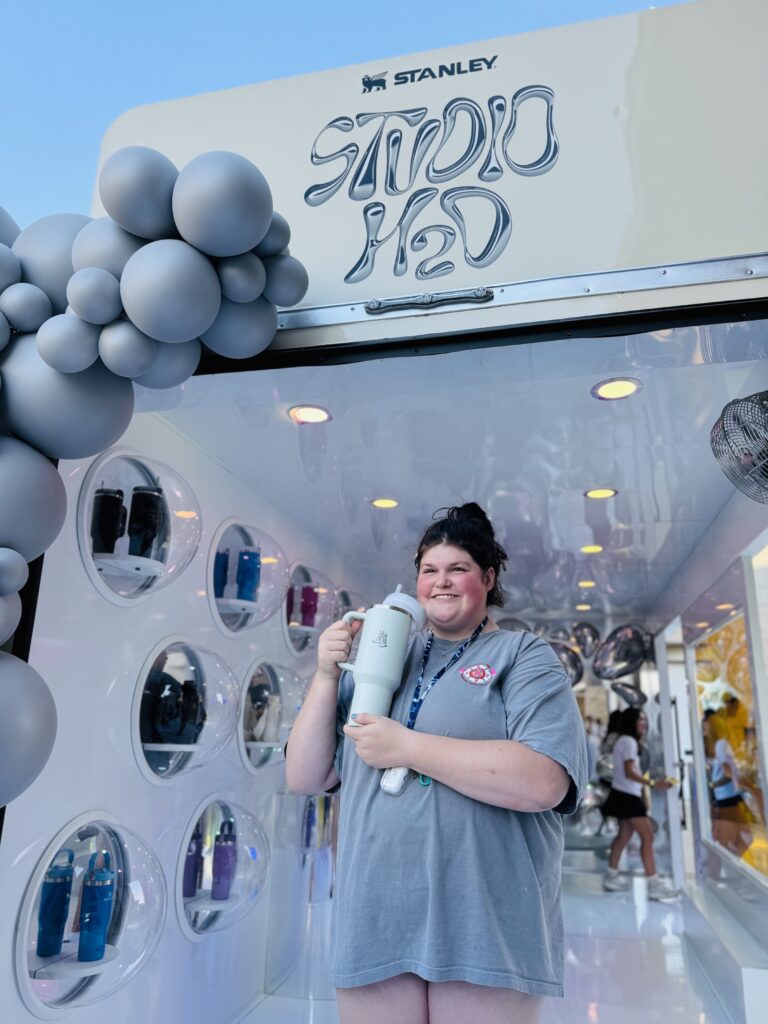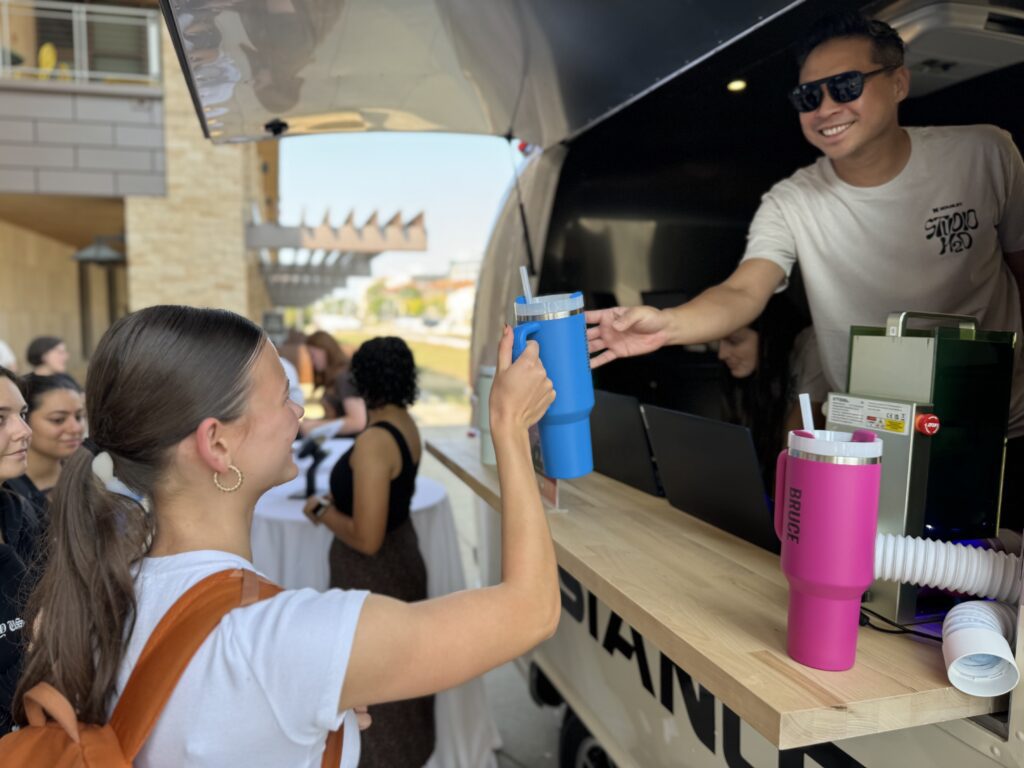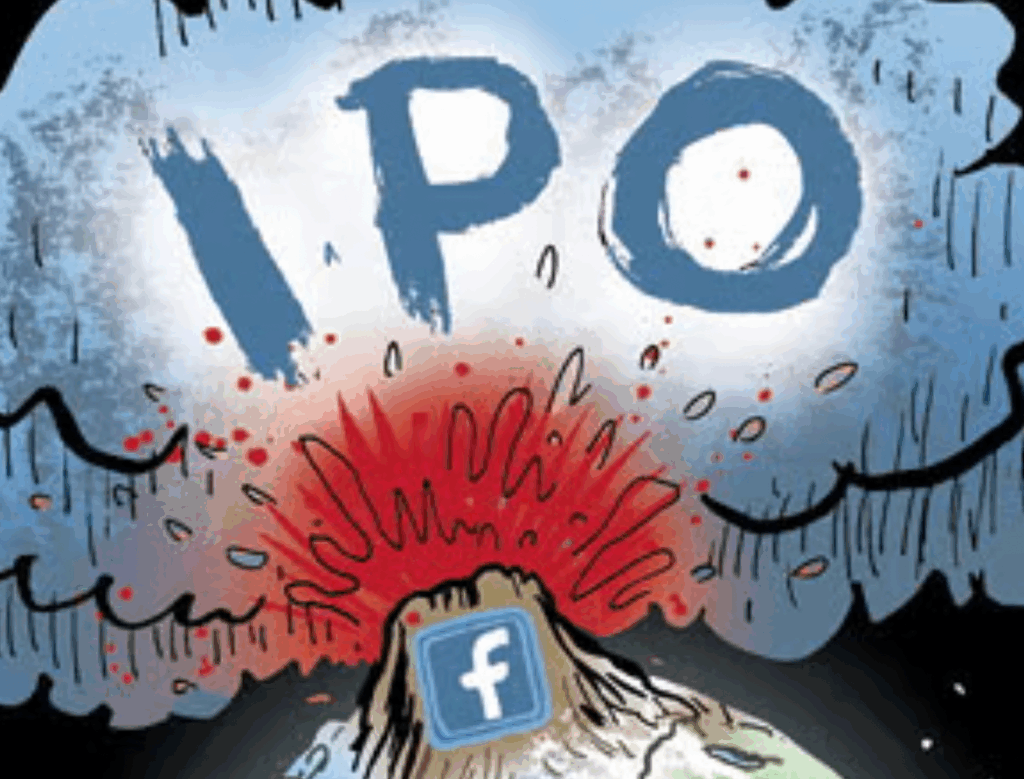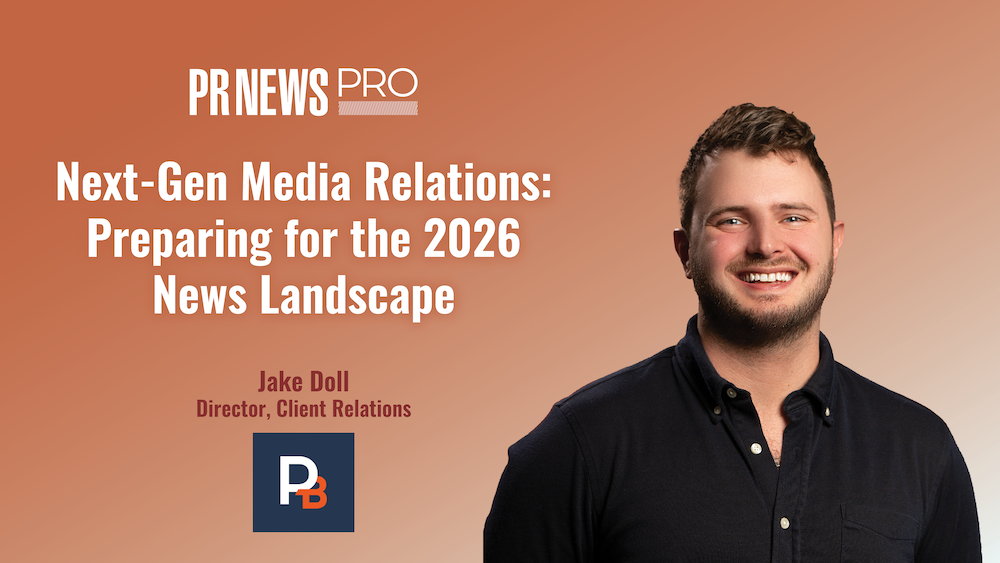Thanks to an explosion of user-generated content surrounding the company’s insulated tumbler products, Stanley’s organic social and digital engagement is likely envied by more than a few brands. The “pack my Stanley with me” TikTok trend, for instance, has users converting the tumblers into mini backpacks by attaching a range of accessories to them—adding a whole new purpose to the product and inserting it into the cultural conversation.
But while Stanley excels at engagement from a digital perspective, its latest marketing campaign targeted toward college students intends to build emotional connections through in-person activations. The Stanley Studio H2O pop-up tour, a brand experience that offers students free engraving with a product purchase, is visiting 13 college campuses across the country this fall. An ambassador program, NIL [name, image, likeness] athlete partnerships and a consumer insights platform to drive CRM efforts support the 360 campaign.
“As we think through where we want to be today and tomorrow, we need to deepen the emotional connection we have with Gen Z consumers,” said Graham Nearn, Chief Brand Officer at Stanley. “And there is no better way to deepen that emotional connection than meet these consumers where they are living their daily lives when they’re at college.”
We spoke with Nearn about the campaign’s goals, student ambassador strategy, product innovation and the 113-year-old brand’s approach to tapping into culture by creating relevance.
Chief Marketer: Why did the brand go with an experience for this campaign? And what are your main marketing goals?
Graham Nearn, Chief Brand Officer at Stanley: Over the last two to three years, we’ve been able to create really meaningful dialogue with Gen Z consumers… for the most part digitally. And it’s been fantastic. But as we think through where we want to be today and tomorrow, we need to deepen the emotional connection we have with Gen Z consumers. And there is no better way to deepen that emotional connection than meet these consumers where they are living their daily lives when they’re at college. It’s such a formative part of young people’s experience. And we want to be there as part of their daily lives.
If we can create more meaningful and deeper relationships with students on college campuses, we can be more meaningful through their daily lives on college campuses and beyond. We also think that if we can get them to fall in love with our brands, we can create that “built for life” promise that we’ve created for their parents and for their grandparents before them. So our goals were to deepen the emotional connection, create loyalty and also ensure that we have fun and bring them into our Stanley ecosystem.
CM: How is the brand working to meet those goals?
GN: We try to do that in four different ways. The first part is, this spring we started an engagement program with student ambassadors across 13 schools. We have 60 student ambassadors who are creating experiences and content for their peers. They conducted 40 different campus events for us, whether walks, picnics or sport occasions.
The second way we’re doing it is we recognize the importance of sports and fitness in college lives. So we’ve developed relationships through an NIL program to connect our brand to students who love sports and fitness and the culture of sports and fitness. We have six NIL athletes who we created relationships with and who creating programming for us… across five different campuses.
And then the third way we’re doing it: We’re bringing a Stanley experience directly to college campuses nationwide through a mobile pop-up tour. Here students can immerse themselves in our brand. They can purchase and engrave products and participate in an activation. In our 13 schools, we have 22 activation days across that mobile tour.
The fourth way is through engaging in a proprietary campus media platform. This is via a nationwide giveaway to promote the campus tour and also allows us to gain consumer insights via a custom Stanley survey. So we get to drive a little bit more CRM. The campus media platform reaches 2,000 schools—that’s over 4 million emails. We’ll have about a hundred thousand research survey sends across the campus media platform.
The end goal is to deepen the emotional connection and our “built for life” promise where we can be part of these students’ lives at college, but hopefully when they graduate and go into wherever their life journey takes them. It’s pioneering work for Stanley and it helps us drive relevancy alongside of course our legacy.
CM: With the ambassador program, what are the major brand benefits? Feeding product innovation?
GN: You are absolutely right. We’re able to showcase some of our latest innovation and technology from a product point of view. We equipped our student ambassadors with some of our latest innovations. A good example is our Stanley Cross Bottle, a product that is the first non-round, double-wall vacuum insulated bottle, we believe, to be launched across the world. For instance, at Cornell University, our student ambassador organized a group hike using the Stanley Cross Bottle. So we’re able to put Stanley into the center of a student’s life and how that student brings together other students to participate in an occasion. Having the ambassador work to bring together other students deepens the connection and dialogue, and provides more authentic and richer storytelling.
Another thing we did was at Georgia State: One of student ambassadors organized a sip-and-paint pool party. That particular ambassador had one of our more popular, famous products, our H20 FlowState Quencher, and was able to bring the benefits of hydration to life—the fact that our Quencher keeps water and ice cold and intact for over 12 to 15 hours around the sip-and-paint pool party, where hydration is part of student pool culture.
At University of Miami, we did a campus pop-up with beach volleyball where we were able to again showcase our hydrate promise with our Cross Bottle. And it’s happening in real life. It’s not some kind of confection or some fiction that’s been made up. This is real, this is authentic, and it’s student originated.

CM: Gen Z audiences require brands to be responsible from a sustainability perspective. How is Stanley standing out in that regard, and not simply paying lip service?
GN: One of our core values at Stanley is to create a more sustainable and less disposable life and world. And we have some significant goals and targets against that. For instance, we declared that by 2025, over 50% of the stainless steel we use in our products would be recycled. We actually think in 2025 we’re going to smash that target and have well over 63-64% of our products using recycled stainless steel. We are also ensuring that all of our stainless steel [is from] ethical A-grade factories. We have ambitious targets and we have definitive action plans against our sustainability and disposability values, and we also know that aligns with Gen Z values and student values.
When it comes to our Studio H20 campus tour, we’re doing it in conjunction with Water for People, a global nonprofit working across nine countries in Latin America, Asia and Africa to address global water crisis and to equip communities with access to clean water and sanitation services.
CM: Stanley collaborates with other brands and celebrities—more recently Barbie. How do you choose those partnerships?
GN: When we look at collaborations, we also look at the “fields of play” that are most important for Stanley and for consumers. Fields of play could be, for instance, sports and fitness. We recognize the value of hydration and a healthy sports and fitness lifestyle. We also recognize a field of play in style and fashion, and how important function and style are, and where we want to be: at the intersection of style and culture.
Once we articulate a field of play, then we want to partner with folks or organizations or teams that share the same values as we do, and those values are underpinned on doing the right thing, on ensuring that we have appropriate integrity, on creativity building and invention and having fun.
These partnerships allow us a two-plus-two-equals-five relationship. We launched our Barbie collaboration [last month] through an immersive experience in New York City, and then in London, Houston and L.A. And that was about a meeting of two amazing icons, Stanley and Barbie, that were always destined to be best friends.
Barbie and Stanley share values. We share values of authenticity, self-expression and empowerment. We have eight Barbie and Stanley legendary eras that were celebrating, from iconic Barbie to Rocker Barbie to Western Ken Barbie. It allows the consumer to engage, to have fun, to be inspired, but also to recognize the values of empowerment and self-expression across two great brands.
CM: What else has helped the brand tap into culture effectively?
GN: The power of relevancy and originality. And in order to create relevancy, you have to be authentic as well. The authenticity part of Stanley is through product innovation. We focused heavily on where consumers and culture are when it comes to food and beverage containment. And within that, the biggest and most powerful category is hydration. So we drove product innovation in the hydration part of consumers’ lives. And that product innovation, of course, is creating a product that can be part of a consumer’s lifestyle who wants to look good and feel good.
Product innovation through a “look good, feel good” lifestyle is about ensuring that you have the right volume and the thermal promise is absolutely robust. As you probably know, Stanley invented double-wall vacuum insulation in 1913. It’s the foundation invention of our industry. With our H2O FlowState Quencher, for example, that’s 40 ounces of water that’s hot and cold for up to 15 hours. It’s cup holder-friendly. It has a three-stage lid. It has an easy, economic handle. And it comes with beautiful color material and finishing.
Color material and finish innovation was one of the most important parts of ensuring that relevancy and that we were part of a cultural zeitgeist. With some of the colors, prints and the patterns we’ve done, I think consumers look at the functionality of the product, they look at the color material and finish of the product, and go, that is right there at the epicenter of how I want to live my life. It performs fantastic, it’s beautiful with my outfit and it looks great. I think if you can use your authenticity, use performance innovation and be where consumers are always, you give yourself the best chance.






